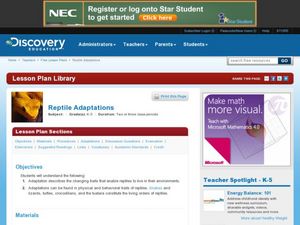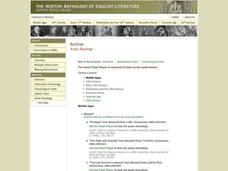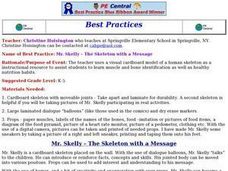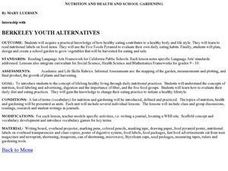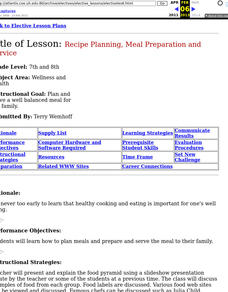Curated OER
Coral Polyp Party
Students complete a project where they label the parts of a coral polyp and discuss the differences between plants and animals. Students use marshmallows, sprinkles, toothpicks, and more to label their coral polyp.
Curated OER
Classroom Supplies
Challenge young mathematicians to buy classroom supplies by staying within the means of a $1,000 budget. The mathematical activity provides learners with the opportunity to decide what items from the supply list would benefit a class of...
Curated OER
Reptile Adaptations
Pupils research animal adaptations. For this adaptations lesson, students research the physical and behavioral adaptations of animals. Pupils create a diagram of their animal labeling it's adaptations.
Curated OER
The Luck of the Irish
Students are introduced to a variety of customs and traditions relating to the culture of Ireland. They view a video, explore the art of storytelling, research sport origins, cook Irish food and discuss well-known Irish proverbs.
Curated OER
How Are Plants Similar And Different?
Studetns create an index card database of different categories of plants such as bushes, trees, flowers, grasses and vegetables. They review the different parts of a plant and label pictures of plants on the database cards. They use the...
Illustrative Mathematics
Quinoa Pasta 1
Here is a great opportunity to introduce your mathematicians to a food they may never have heard of, quinoa. It may help to show a short video on quinoa, or make some quinoa for the class to try. Once they get over how to say quinoa,...
Curated OER
Using Menus
Students practice foreign language vocabulary and problem solving, by asking questions and ordering from a menu. Working in pairs, students role play activities related to ordering from a menu in a foreign language. Activities for...
Curated OER
Health: The Skeleton with a Message
Students identify human muscles and bones from a cardboard skeleton, named "Mr. Skelly." Using dialog balloons as props, the teacher holds up advice from Mr. Skelly, such as noting he drinks milk to keep his bones strong. The lesson...
Curated OER
Critters in the Classroom
Students investigate with sea urchins. In this ocean habitat lesson, students observe sea urchins and other ocean grazers. Students work with lab equipment to examine the anatomy of these creatures.
Curated OER
The Science Behind Dolphins
Young scholars discover facts about marine mammals, specifically dolphins. In this K-2 lesson plan, students identify the different species of Cetaceans, focusing on dolphins. Young scholars answer true/false questions regarding...
Curated OER
Don't Worm Your Way Out of This One!
Students study different aspects of worms along with the process of vermicomposting by participating in a class experiment to study the time it takes for breakfast cereal to be eaten by worms.
Curated OER
Dynastic Explorations
Students complete a unit of lessons on medieval Chinese dynasties. They examine the impact the Chinese culture has had on their own lives, label maps, conduct research, read stories, create bamboo stick sentences, write poems, and make...
Curated OER
Knowing your nutrients
Learners comprehend the basics of the nutrition label. They comprehend the Recommended Daily Allowances. Students analyze the regulations that govern food labeling. They review the Food Pyramid.
Curated OER
Dribbling for Nutrition
Students practice reading food labels and determining the correct number of grams of fat and carbohydrates in a single serving. They work on improving dribbling skills during the task.
Curated OER
Visual Representation of Reduced Fat
Students demonstrate their understanding of the Five-Number Summary and Box-Plots by analyzing different nutrition labels from regular and reduced fat items using graphing calculators.
Curated OER
What's on Your Plate?
Learners examine the food that they eat and choose snacks that are healthy and low in fat. In this healthy food lesson students keep a food log of what they ate, graph the results and experiment with food to see which foods...
Curated OER
Snack Attack
Students choose healthy snacks. They are given a point for a snack that is low in fat and sugar. Students recieve a bag of apples or oranges once a week for the winning homeroom. They have a list of suggested snacks in each homeroom,...
Curated OER
Nutrients by the Numbers
Students read and discuss an article on the amount of sugar in various food products. They compare the nutritional values of food products, calculate their daily intake of nutrients, analyze serving sizes, and compare/contrast their own...
Curated OER
Nutrition and Health and School Gardening
Students examine how healthy eating contributes to a healthy body and life style. They read nutritional labels on food items. They use the Five Foods Pyramid to evaluate their own eating habits. They plan, design, and create a school...
Curated OER
Moooving to Low-fat Milk
Third graders complete two handouts. In this healthy beverages lesson, 3rd graders compare whole, two percent and skim milks. Students use labels to help choose healthy beverages. Students complete an "All About Milk" and "Calculating...
Curated OER
You Are What You Eat (Grades 5-8)
Students gain an enhanced understanding of the relationship between proper nutrition and good health. Through use of video, hands-on activities and interaction, students measure energy in food, and recognize sources of vitamins and...
Nemours KidsHealth
Healthy Snacking: Grades 3-5
Students investigate healthy snack foods. In this healthy snack foods instructional activity, students discover what good snacks consist off and how healthy snacking can improve health. They design the perfect snack machine using the...
Curated OER
Recipe Planning, Meal Preparation and Service
Students examine how to plan, prepare, and serve a meal. They analyze the food pyramid, select five recipes, plan a dinner menu, create a HyperCard stack of the menu, and prepare the meal for their family.
Curated OER
Nutrition
Fourth graders engage in an original unit about nutrition and record daily intake of food in order to help create a healthy eating plan. They practice making practical food choices for optimum health and then investigate how to maintain...


